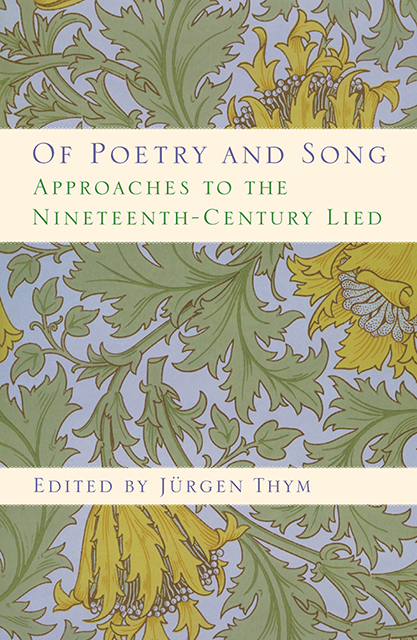Chapter Two - The Musical “Spirit” of Goethe’s “Suleika”: Schubert’s Settings D. 720 and D. 717
Published online by Cambridge University Press: 02 March 2023
Summary
Schubert's settings of Goethe's lyric poems, but for some notable exceptions (e.g., “Gretchen am Spinnrad” and “Erlkönig”), have traditionally received only grudging and partial approval from literary critics and musicologists. Goethe scholars have been even more patronizing toward the composer's two “Suleikalieder.” Schubert's settings, it is said, are brilliant musical creations, but they do not reflect Goethe; the “Suleikalieder” in particular do not even represent Goethe, since the poems were written by Marianne von Willemer. Despite such caveats, I submit that Schubert's settings D. 720 and D. 717 are not only superb in themselves but also provide intellectual and intuitive insights into Goethe's West-östlicher Divan as a whole. The truth of my assertion can be seen in a detailed structural analysis of poem and music, with an interpretive synthesis of both.
The Suleika poems as they stand are a moving statement of a basic emotion: a woman in love, separated from her lover but with hopes for a reunion, confesses that this mere hope constitutes her very life. Apart from the central metaphoric device—the East and West winds—and the Oriental motive (dust), there seems no obvious or compelling reason for Goethe's inclusion of both poems in his Divan, the collection that presents the intellectual and aesthetic aspects of love on a cosmic and philosophical scale but treats them in colloquial, aphoristic terms. Yet on closer examination, one finds such key words of Goethe's late period as “Liebe,” “Leben,” “Atem,” and “Liebeshauch” in the deceptively simple trochaic tetrameter stanzas. Indeed, within the confessional context of Suleika's monologues, these Goethean concepts could even be said to be out of place. Schubert's music, however, qualitatively transforms Suleika's musings, fusing Goethe's metalyrical philosophizing and Willemer's emotional aspirations into a synthesis that is more than the sum of its parts.
Goethe and Marianne von Willemer last saw one another in Heidelberg in late September 1815. “Was bedeutet die Bewegung?” was written in a stagecoach en route from Frankfurt to Heidelberg and “Ach, um deine feuchten Schwingen” during the return trip to Frankfurt. However, it was Willemer, not Goethe, who wrote these two poems, and she, not he, was the creator of what had been taken to be all but perfect examples of a male poet's ability to express empathetically in poetry the soul of a woman in love.
- Type
- Chapter
- Information
- Of Poetry and SongApproaches to the Nineteenth-Century Lied, pp. 39 - 70Publisher: Boydell & BrewerPrint publication year: 2010



